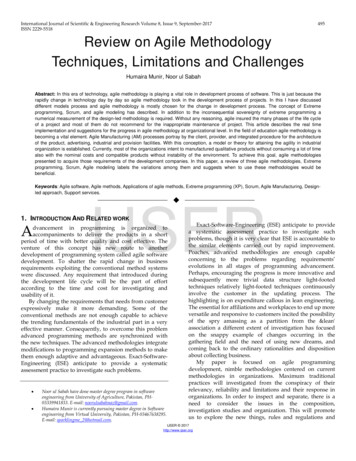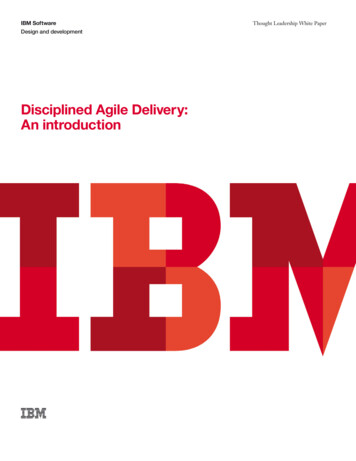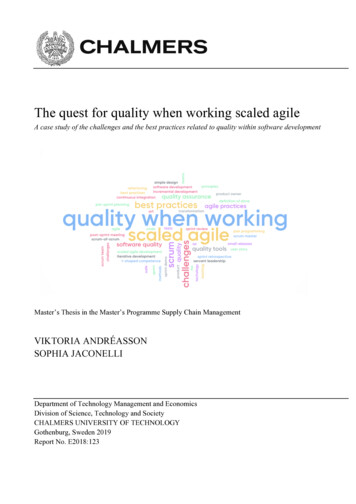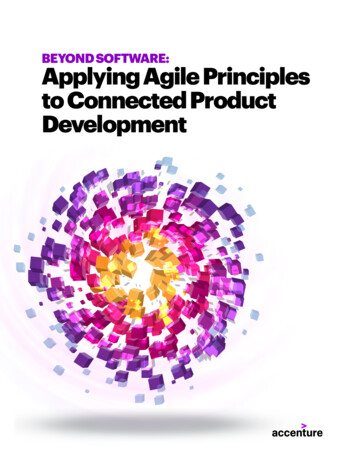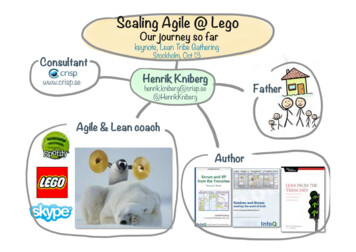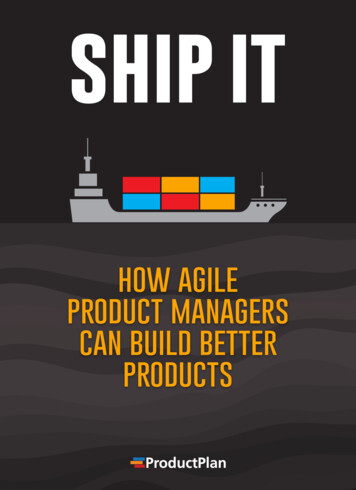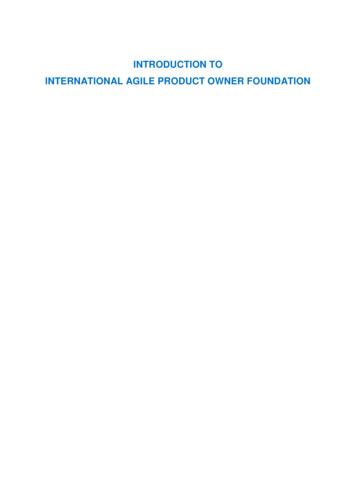
Transcription
INTRODUCTION TOINTERNATIONAL AGILE PRODUCT OWNER FOUNDATION
Table of Contents01 INTRODUCTION TO "INTERNATIONAL AGILE PRODUCT OWNER FOUNDATION"402 CREATE PRODUCT VISION2.1 Four Steps to create a Product Vision6603 IDENTIFY PEOPLE REQUIREMENTS3.1 The four main actors in Scrum9904 FORM THE TEAM4.1 Skills4.2 Working with HR on formation of the Scrum Team10111305 DEVELOPING EPIC STORIES1506 PRODUCT BACKLOG6.1 Product Backlog6.2 Product Backlog between Product Owner and Scrum Team16161707 WORKING WITH PRODUCT BACKLOG7.1 DEEP7.2 Grooming the Product Backlog7.3 Prioritizing the Product Backlog1919202108 RELEASE PLANNING7.1 Release planning8.2 Release Prioritization Methods8.3 Release Planning Schedule8.4 Length of Sprint8.5 Target Customers for Release8.6 Refined Prioritized Product Backlog2424242425252509 USER STORIES9.1 A User Story9.2 Creating User Story9.3 Format for creation of User Story9.4 User Story Acceptance Criteria9.5 INVEST criteria for User Stories26262627272710 APPROVE, ESTIMATE AND COMMIT USER STORIES10.1 Planning Poker10.2 Fist of Five10.3 Points for Cost Estimation10.4 Wideband Delphi10.5 Relative Sizing and Story Points10.6 Affinity Estimation10.7 Estimate Range282830303131313111 CREATE AND ESTIMATE TASKS11.1 Sprint Planning Meeting11.2 Index Cards11.3 Decomposition11.4 Dependency Tree11.5 Output from the Sprint Planning Meeting11.6 Task Estimation in the Sprint Planning Meeting32323232323334
11.6 Estimation criteria3412 CREATE SPRINT BACKLOG12.1 Sprint Backlog12.2 Sprint Burndown Chart12.3 Sprint Velocity3535353613 DEMONSTRATE AND VALIDATE SPRINT13.1 Sprint Review Meeting13.2 Accepted Deliverables13.3 Rejected Deliverables3838383814 SHIP DELIVERABLES14.1 What to ship14.2 Working Deliverables Agreement14.3 Working Deliverables14.4 Product Releases14.5 Piloting Plan39393939393915 RETROSPECTIVE15.1 Retrospect Sprint15.2 Retrospect Project404041
01 INTRODUCTION TO "INTERNATIONAL AGILE PRODUCT OWNERFOUNDATION"This course is the foundation course to become a professional Product Owner. Before youtake this course, you have passed the International Scrum Master Foundation, which hastaken you through all the fundamental knowledge of the Scrum Method.The course gives you a deeper understanding of the Task a Product Owner does. It alsogives you techniques and methods for becoming a successful Product Owner.Who should take this course: As this is a foundation course, everyone who is interested inScrum should take it. Project leaders: who are interested in the Product or Scrum Master role, will benefitfrom this course which gives you access to becoming a certified Advanced ProductOwner. Scrum Team members: will also benefit from this course, as it gives youunderstanding of the job the Product Owner has to perform, and what expectationyou as a Scrum Team member should have towards your Product Owner.The Product Owner represents the interests of the Stakeholder community towards theScrum Team. The Product Owner is responsible for ensuring clear communication of productor service functionality requirements to the Scrum Team, defining Acceptance Criteria, andensuring those criteria are met. In other words, the Product Owner is responsible forensuring that the Scrum Team delivers value.The Product Owner must always maintain a dual view. He or she must understand andsupport the needs and interests of all Stakeholders, while also understanding the needs andworkings of the Scrum Team. Because the Product Owner must understand the needs andpriorities of the Stakeholders, including Customers and users, this role is commonly referredto as the Voice of the Customer.The Product Owner’s responsibilities in the various Scrum processes and this course willtake you through this in more details:ProcessCreate Product VisionIdentify PeopleRequirementsForm Scrum TeamDevelop Epic(s)Create Prioritized ProductBacklogConduct Release PlanningCreate User StoriesApprove, Estimate andCommit User StoriesCreate TasksEstimate TasksProduct Owner Responsibilities Defines the Product Vision Helps organize Scrum Teams for the project Identifies Stakeholder(s) and Scrum Master(s) Helps select Scrum Team members Helps develop a Collaboration Plan Helps develop the Team Building Plan with ScrumMaster(s) Creates Epic(s) and Personas Prioritizes Prioritized Product Backlog Items Defines Done Criteria Creates Release Planning Schedule Helps determine Length of Sprint Helps create User Stories Defines Acceptance Criteria for every User Story Approves User Stories Facilitates Scrum Team and commits User Stories Explains User Stories to the Scrum Team while creatingthe Task List Provides guidance and clarification to the Scrum Team inestimating effort for Tasks
Create Sprint Backlog Create DeliverablesGroom Prioritized ProductBacklogDemonstrate and ValidateSprint Ship Deliverables Retrospect Project Clarifies requirements to the Scrum Team while creatingthe Sprint BacklogClarifies business requirements to the Scrum TeamGrooms the Prioritized Product BacklogAccepts/Rejects DeliverablesProvides necessary feedback to Scrum Master andScrum TeamsUpdates Release Plan and Prioritized Product BacklogHelps deploy Product Releases and coordinates this withthe CustomerParticipates in Retrospect Sprint MeetingsOther responsibilities of a Product Owner are: Determining the project's initial overall requirements and kicking off project activities,this may involve interaction with the Program Product Owner and the PortfolioProduct Owner to ensure that the project aligns with direction provided by seniormanagement. Representing user(s) of the product or service with a thorough understanding of theuser community. Securing the initial and ongoing financial resources for the project. Focusing on value creation and overall Return on Investment (ROI). Assessing the viability and ensuring the delivery of the product or service.
02 CREATE PRODUCT VISIONIn this graph below, we see different levels of detail according to how far away a feature isfrom being implemented. In most agile methods, we like to deliver a release—at least aninternal release—in less than three months. Therefore, when you are more than threemonths away from delivery, all you really need is an overall vision for the release. Whatmarket is the software going to serve, what kind of value is it going to provide, what are thebasic things the software is going to do? You may have a product vision document or amission statement.Figure: Focus on more detail over time. Focus: Vision, Features, Stories,Specification and Software; Time: 3 months, 6 weeks, 2 weeks, Finished.Copyright James ShoreThis is an idealized view of the world. In practice, we do not proceed smoothly from vision, tofeatures, to stories, to specification, on the clear, crisp timeframe described here. Reality ismessier and it can be hard to know when to go into more detail. However, the overall point isvalid: you do not need all of the details in advance.The first stage in an Agile Project is defining your product vision. The product VisionStatement is an elevator pitch—a quick summary—to communicate how your productsupports the company's or organization's strategies. The Vision Statement must articulatethe goals for the product.The Product Owner is responsible for knowing about the product, its goals, and itsrequirements throughout the project and takes responsibility for creating the VisionStatement, although other people may have input. The Vision Statement becomes a guidinglight, the "what we are trying to achieve" statement that the Development Team, ScrumMaster, and Stakeholders refer to throughout the project.Anyone involved with the project, from the Development Team to the CEO, should be able tounderstand the product Vision Statement.2.1 Four Steps to create a Product VisionFour Steps to create a Product Vision:1. Developing the agile product objective2. Creating a draft Agile Vision Statement
3. Validating and revising the Agile Vision Statement4. Finalizing your Agile Vision Statement2.1.1 Developing the agile product objectiveTo write your Vision Statement, you must understand and be able to communicate theproduct’s objective. You need to identify: Key product goals: How will the product benefit the company creating it? The goalsmay include benefits for a specific department within your company as well as thecompany as a whole. What specific company strategies does the product support? Customer: Who will use the product? This may be more than one entity. Need: Why does the Customer need the product? What features are critical to theCustomer? Competition: How does the product compare with similar products? Primary differentiation: What makes this product different from the status quo, orthe competition, or both?2.1.2 Creating a draft Agile Vision StatementAfter you have a good grasp of the product’s objective, create a first draft of your VisionStatement. In creating your Vision Statement, you help convey your product's quality,maintenance needs, and longevity.One way to make your product Vision Statement more compelling is to write it in the presenttense, as if the product already exists. Using present tense helps readers imagine theproduct in use.A Vision Statement identifies a future state for the product when the product reachescompletion. The vision focuses on the conditions that should exist when the product iscomplete.Avoid generalizations in your Vision Statement such as "make Customers satisfied" or "sellmore oil". Also, watch out for technological specificity, such as "using HTML5, create ainterface with four external calls that.".At this early stage, defining specific technologies may limit you later. A few extracts fromunsuitable Vision Statements that should ring warning bells: "Secure additional Customers for the SuperApp application" (!) "Satisfy our Clients by September" (!) "Remove all issues and improve quality" (!) "Create a new application in HTML5" (!) "Beat Facebook to market by six months" (!).2.1.3 Validating and revising the Agile Vision StatementAfter you draft your Vision Statement, review it against a quality checklist: Is this Vision Statement clear, focused, and written for an internal audience? Does the statement provide a compelling description of how the product meetsCustomer needs? Does the vision describe the best possible outcome? Is the business objective specific enough that the goal is achievable? Does the statement deliver value consistent with corporate strategies and goals? Is the project Vision Statement compelling?These yes-or-no questions help you determine whether your Vision Statement is thorough. Ifany answers are no, revise the Vision Statement.
When all answers are yes, move on to reviewing the statement with others, including: Project Stakeholders: The Stakeholders will be able to identify whether the VisionStatement includes everything the product should accomplish. Your Development Team: Because the Team will create the product, it mustunderstand what the product needs to accomplish. Scrum Master: A strong understanding of the product helps the Scrum Masterremove roadblocks and ensure that the Development Team is on the right path laterin the project. Agile Mentor: Share the Vision Statement with your Agile Mentor, if you have one.The Agile Mentor is independent of the organization and can provide an externalperspective, qualities that can make for a great objective voice.Discover whether others think the Vision Statement is clear and delivers the message youwant to convey. Review and revise the Vision Statement until the Project Stakeholders, theDevelopment Team, and the Scrum Master fully understand the statement.At this stage of your project, you may not have a Development Team or Scrum Master. Afteryou form a Scrum Team, be sure to review the Vision Statement with it.2.1.4 Finalizing your Agile Vision StatementMake sure your Development Team, Scrum Master, and Stakeholders have the final copy ofthe Vision Statement. You can even put a copy on the wall in the Scrum Team's work area,where everyone can see it every day. You refer to the Vision Statement throughout the life ofthe project.If your project is more than a year long, you may want to revisit the Vision Statement to makesure the product reflects the marketplace and supports any changes in the company's needs.
03 IDENTIFY PEOPLE REQUIREMENTSIdentifying People Requirements is one of the initial steps in selecting the Scrum Master andthe Stakeholder(s). It is important to document the roles and responsibilities of all those whowould be involved in completing the Tasks in the project. This includes all individualsinvolved in the project in any capacity, regardless of whether their role is core or non-core.3.1 The four main actors in ScrumIn Scrum there are four main actors The Stakeholders The Product Owner The Scrum Master The Team (see Chapter 4).Usually, the Product Owner or the Scrum Master work with the Human Resource Departmentof the company to determine and finalize the People Requirements for a project.Prior to selecting the Scrum Master and Stakeholder(s), their availability must be confirmed.Only Team members who will be available and can fully commit to the project should beselected. People Availability and Commitment are commonly depicted in the form ofcalendars showing when human resources will be available to work throughout the durationof the project.To be effective, Scrum Teams should ideally have six to ten members; and replacingpersons or changing Team members is not advisable in Scrum Core Teams. Therefore, it isimportant to have persons in the Scrum Core Team who are available and fully committed tothe project.3.1.1 Stakeholder(s)Program Stakeholder(s) is a collective term that includes Customers, users, and sponsors fora program. They influence all the projects in the program throughout the project’sdevelopment. Program Stakeholder(s) can also help define the project vision and provideguidance regarding business value.Program Stakeholder(s) interface with Portfolio Stakeholder(s) to ensure alignment of theprogram with the goals and objectives of the portfolio. They are also involved with appointingStakeholder(s) for individual projects and ensuring that the vision, objectives, outcomes, andreleases of individual projects in the program align with that of the program.3.1.2 Choosing the right Product OwnerFinding the right person to fill the Product Owner role is challenging. How do we as acompany choose the right person to be Product Owner?In general, there are two ways to organize Scrum Teams: Feature Teams Component Teams3.1.2.1 Feature TeamsA Feature Team implements a cohesive set of requirements, such as one or more themes offeatures. The result is an executable vertical slice that cuts across major parts of thesoftware architecture. Feature Teams are organized around the Product Backlog.3.1.2.2 Component TeamsA Component Team creates a component or subsystem. Component Teams are organizedaround the software architecture.
Both Team setups have advantages and disadvantages. Component Teams ensurearchitectural integrity and reuse. Unfortunately, they often cannot utilize Product Backlogitems expressed as User Stories or use cases but require detailed technical requirements.Feature Teams, on the other hand, can normally work in parallel. They encounter fewerintegration issues and can utilize the requirements stated in the Product Backlog. Ensuringarchitectural integrity and reuse can be a challenge. As a rule of thumb, companies shouldemploy Feature Teams whenever possible and use Component Teams only if absolutelynecessary.3.1.2.3 Common mistakes when choosing Product OwnerFinding the right Product Owner can be difficult, here a list of common mistakes: The underpowered Product Owner The overworked Product Owner The partial Product Owner The distant Product Owner The proxy Product Owner The Product Owner Committee Product OwnerIn the advanced course we will go into detail regarding these mistakes.3.1.3 Scrum Master(s)The Program Scrum Master is a facilitator who ensures that all Project Teams in the programare provided with an environment conducive to completing their projects successfully.The Program Scrum Master guides, facilitates, and teaches Scrum practices to everyoneinvolved in the program. Provides guidance to Scrum Masters of individual projects Clears away impediments for the different Project Teams Coordinates with the Scrum Guidance Body to define objectives related to quality,government regulations, security, and other key organizational parameters Ensures that Scrum processes are being effectively followed throughout the program.The Program Scrum Master interfaces with the Portfolio Scrum Master to ensure alignmentof the program with the goals and objectives of the portfolio. He or she is also involved withappointing Scrum Masters for individual projects and ensuring that the vision, objectives,outcomes, and releases of individual projects in the program align with those of the program.Large projects require multiple Scrum Teams to work in parallel. Information gathered fromone Team may need to be appropriately communicated to other Teams—the Chief ScrumMaster is responsible for this activity.Coordination across various Scrum Teams working on a project is typically done through theScrum of Scrums (SoS) Meeting. This is analogous to the Daily Standup Meeting and isfacilitated by the Chief Scrum Master. The Chief Scrum Master is typically responsible foraddressing impediments that affect more than one Scrum Team.To learn about the Scrum Team, turn to Chapter 4.04 FORM THE TEAMFormation of the Scrum Team is a very important Task. The Scrum Team is at the heart ofthe process since these are the people who will realize the Product Owner's vision.
This vision is nothing except a list of features that the Product Owner wants, with no unifyingprinciple or clear goal. This does nothing to guide the Team (or inspire the Team). It alsorarely passes the elevator test and usually is difficult to remember. What it adds up to is thatit does nothing to align the Team or help them make decisions, and as a result, the "secretsauce" in Scrum (self-organization) never emerges or emerges misdirected.4.1 SkillsWith "self-organization" comes responsibility and commitment. Therefore, the Product Ownerhave to look at more than just technical skills when selecting his or her Team. Some of theskills that normally are also needed are: Self-organization skills Communication and collaboration skills.4.1.1 Self-organization skillsSelf-organization is the ability to work in an ordered and methodical manner whilst beingefficient and productive. Good self-organizational skills help us to cope with the world aroundus and are essential if we want to achieve personal goals as well as perform well in our job.These skills help keep us focused on doing the right Tasks, help us set our priorities and giveus the confidence that we are following our chosen pathway to our desired destination.Good self-organization requires the ability to prioritize, plan, manage time and work todeadlines. Self-organization is required for managing our time, resources, relationships,information, our environment, pressure and stress, and our behavior.Limited self-organization skills may cause difficulties such as: Planning: setting achievable and realistic goals Implementing a systematic and organized strategy to achieve these objectives Identifying priorities Organizing one’s workload to maximize results Taking personal responsibility to achieve/exceed standards and expectations Taking responsibility to enhance one’s professional development by addressing andovercoming any weaknesses and fully utilize one’s strengths.4.1.2 Communication and collaboration skillsScrum attempts to simplify the often-confusing web of relationships through defining a clearset of roles and responsibilities.
Figure: Scrum Communication Model. The Scrum Team, Product Owner, TheTeam, Scrum Master; Customers and Stakeholders, User Community, ManagementWithin the inner circle we find the Scrum Team. This includes the Product Owner, ScrumMaster and the Team. Within this boundary, there should be no barriers to communication.This Team is collectively held accountable for the success of the product, and there shouldbe an open dialogue between all its members.The outward focus of the Scrum Team’s communication is also illustrated above. TheProduct Owner’s focus of communication should be with Customers (who pay the bill) andother Stakeholders who may have an interest in the product. Ensuring that their voices areheeded in the development of the product is vital to ensure its successful outcome.Through the interactions within this group, we can better understand what to build, but evenmore importantly, when to stop building functionality. The value of code not written is difficultto measure but undeniable; we have no need to build, maintain, debug, test or release thiscode.The Team should as far as possible communicate directly with the user community.Sometimes this may be the same as the Customer (if you are dealing with a direct Customerfacing product). However, where this is not the case (as in many enterprise scaleapplications) having the Product Owner as a proxy or conduit for information from users isnot advised. Face-to-face interaction (or at least direct communication) between the usercommunity and the Team reduces the likelihood of miscommunication.It is often the case that the Scrum Master might interpret his or her mandate to "protect theTeam" over-zealously, and attempt to limit or eliminate interaction between the Team andusers. However, this information is essential to the Team. The Scrum Master should protectthe Team from interruptions, not information.
Figure: Organization in Scrum.Customer—The Customer provides his/her requirements to the Product Owner.Product Owner—"The Voice of the Customer": The Product Owner delivers business value to theCustomer through Incremental Product Releases. The Product Owner communicates the prioritizedbusiness requirements to the Scrum Team, creates the Prioritized Product Backlog, and defines theAcceptance Criteria.Scrum Master—The Scrum Master ensures a proper work environment for the Scrum Team.Scrum Team—The Scrum Team demonstrates product increment to the Product Owner during theSpring Review Meeting. The Scrum Team creates the Deliverables of the Project.4.2 Working with HR on formation of the Scrum TeamJust as in other projects, we normally have to go through the HR department to obtainresources to form the Team, and in some cases, the Scrum Team is also part of a programor a project, which is a layer on top that controls the budget.If you are a Product Owner you will have to go through the normal administrative processesin the company to assemble your Team. This involves some or all of the below Tasks orsome other process: People Requirements People Availability and Commitment Organizational Resource Matrix Skills Requirements Matrix4.2.1 People RequirementsIdentifying People Requirements is one of the initial steps in selecting the Scrum Master andthe Stakeholder(s). It is important to document the roles and responsibilities of all those whowill be involved in completing the Tasks in the project. This includes all individuals involved inthe project in any capacity, regardless of whether their role is core or non-core.Usually, the Product Owner or the Scrum Master work with the Human Resource Departmentof the company to determine and finalize the People Requirements for a project.
4.2.2 People Availability and CommitmentPrior to selecting the Scrum Master and Stakeholder(s), their availability must be confirmed.Only Team members who will be available and can fully commit to the project should beselected. People Availability and Commitment are commonly depicted in the form ofcalendars showing when human resources will be available to work throughout the durationof the project.To be effective, Scrum Teams should ideally have six to ten members; and replacingpersons or changing Team members is not advisable in Scrum Core Teams. Therefore, it isimportant to have persons in the Scrum Core Team who are available and fully committed tothe project.4.2.3 Organizational Resource MatrixThe Organizational Resource Matrix is a hierarchical depiction that combines a functionalorganizational structure and a project organizational structure. Matrix organizations bringtogether Team members for a project from different functional departments such asinformation technology, finance, marketing, sales, manufacturing, and other departments,and create cross-functional Teams.Team members in a matrix organization fulfill two objectives—functional and project. Teammembers are directed by Product Owner(s) with respect to project related activities, while thefunctional managers perform managerial activities related to their departments such asperformance appraisals and approving leaves.4.2.4 Skills Requirements MatrixThe Skills Requirement Matrix, also known as a competency framework, is used to assessskill gaps and training requirements for Team members. A skills matrix maps the skills,capabilities, and interest level of Team members in using those skills and capabilities on aproject. Using this matrix, the organization can assess any skill gaps in Team members andidentify the employees who will need further training in a particular area or competency.
05 DEVELOPING EPIC STORIESIn Scrum, the Teams that complete the work assign effort estimates to every User Story. Ofcourse, that assumes that a Team can reach a consensus for an appropriate estimate. Whathappens when a Story includes too many unknowns to tell just how big it is? On the otherhand, what if the Story’s requirements are known, but its effort is too huge to complete in asingle Sprint. We call these stories "Epics". While a Team should be able to tackle a typicalStory in four to sixteen hours, an Epic is a Story that would require twelve or many more tocomplete. Most Scrum experts suggest that any Task requiring twelve or more hours shouldbe decomposed into several smaller Tasks. These stories will not only be smaller in scope,but also more narrowly defined. Breaking down Epics helps the Development Team translateits work into chunks that can be accomplished in a single day.Is there any danger to estimating an Epic? Quite simply, the answer is yes. Estimating Epicscan be harmful because it creates a false sense of certainty for the Product Owner, whobegins to believe that the requirements, Tasks, and effort of the Epic are known. When aTeam estimates an Epic, that estimation is just that—an estimation—but it seldom remains abest guess. It is often used for forecasting, which, in turn, becomes the basis of a budget.When that happens, that estimate is now an inflexible projection that binds the Team tocomplete an unknown amount of work while respecting an established budget.When putting User Stories onto a Product Backlog (or feature list), you should not feelcompelled to break everything down until the features are nearing development. Furtherdown the Product Backlog, its fine for items to be fuzzy. It is also fine for items further downthe Backlog to be whole projects – large, high-level items that are not so much User Storiesbut more like Epics!As an item nears development, the item should be broken down further. In addition, as itnears development, the item on the Backlog should be defined in sufficient detail that theTeam could reasonably estimate its size and break it into Tasks. Until that time, however, it isjust really a placeholder. A reminder for prioritization and high-level estimating. That is all.For some people, particularly those used to a more traditional project approach, who areaccustomed to getting detailed specifications up-front, this can potentially feel veryuncomfortable. It should not. The logic here is simple. There is little point in defining a feature(or set of features) in detail if it may never reach the top of the priority list. The other aspectof this logic is that you tend to know more about your requirements, constraints, etc. as timegoes by. Moreover, things change. People come and go. Sometimes the Team has changedsignificantly since the original requirements emerged, so opportunities can be lost ifinformation is frozen too early. Therefore, it makes business sense to defer details until theyare needed.
06 PRODUCT BACKLOGThe Program Product Owner develops the Program Product Backlog, which contains aprioritized list of high-level business and project requirements, preferably written in the formof major Program Backlog Items or Epics. These are later refined by the Product Owners ofindividual projects as they create and prioritize Product Backlogs for their projects. ThesePrioritized Product Backlogs have much smaller but detailed User Stories that can beapproved, estimated, and committed by individual Scrum Teams.The Program Product Backlog is continuously groomed by the Program Product Owner toensure that new business requirements are added and existing requirements are properlydocumented and prioritized. This ensures that the most valuable criteria for meeting theprogram objectives get high priority, while others are put lower on the list.The Program Product Backlog created for the program presents a larger picture of allprojects that are part of the program. Therefore, it can provide significant guidance regardingproject goals, scope, objectives, and the expected Business Benefits.The Scrum Product Owner uses the Scrum Product Backlog during the Sprint PlanningMeeting to describe the top entries to the Team. The Scrum Team then determines whichitems they can complete during the upcoming Sprint.6.1 Product BacklogEach Scrum Product
3.1 The four main actors in Scrum 9 04 FORM THE TEAM 10 4.1 Skills 11 4.2 Working with HR on formation of the Scrum Team 13 05 DEVELOPING EPIC STORIES 15 06 PRODUCT BACKLOG 16 6.1 Product Backlog 16 6.2 Product Backlog between Product Owner and Scrum Team 17 07 WORKING WITH PRODUCT BACKLOG 19 7.1 DEEP 19 7.2 Grooming the Product Backlog 20


